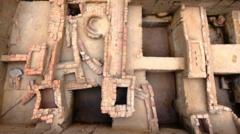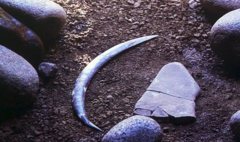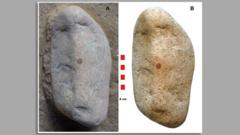Underneath a soccer field in Vienna's Simmering district, a significant archaeological discovery has emerged, revealing a mass grave that dates back nearly 2,000 years. The remains of at least 129 individuals, many showing signs of battle-related injuries, were uncovered during renovations by a construction company last October. Experts from the Vienna Museum reported that this site may be linked to a catastrophic military event, possibly featuring a Roman defeat against Germanic tribes during the peak of the Empire.
Radiocarbon dating of the remains indicates they belong to the period between A.D. 80 and 234, coinciding with the reigns of various Roman emperors, such as Domitian and Trajan, who were known to have clashed with tribes in the region. Alongside the skeletal remains, archaeologists discovered artifacts including an iron dagger, lance points, pieces of scale armor, and a cheek piece from a helmet, all of which corroborate the dating of the site.
Significantly, shoe nails retrieved from one skeleton suggest they were distinctive Roman military footwear known as caligae. The discovery of these uncremated skeletal remains is remarkable, considering that cremation was the prevailing practice among ancient Romans until the third century A.D.
Lead anthropologist Michaela Binder expressed the rarity of such findings, noting, "For all of middle Europe from the first century, we don’t have any unburned, uncremated human remains." The mass grave presents an exceptional opportunity to delve into the life histories of people from the first century A.D., shedding new light on military life during this tumultuous time in Roman history.
Radiocarbon dating of the remains indicates they belong to the period between A.D. 80 and 234, coinciding with the reigns of various Roman emperors, such as Domitian and Trajan, who were known to have clashed with tribes in the region. Alongside the skeletal remains, archaeologists discovered artifacts including an iron dagger, lance points, pieces of scale armor, and a cheek piece from a helmet, all of which corroborate the dating of the site.
Significantly, shoe nails retrieved from one skeleton suggest they were distinctive Roman military footwear known as caligae. The discovery of these uncremated skeletal remains is remarkable, considering that cremation was the prevailing practice among ancient Romans until the third century A.D.
Lead anthropologist Michaela Binder expressed the rarity of such findings, noting, "For all of middle Europe from the first century, we don’t have any unburned, uncremated human remains." The mass grave presents an exceptional opportunity to delve into the life histories of people from the first century A.D., shedding new light on military life during this tumultuous time in Roman history.



















